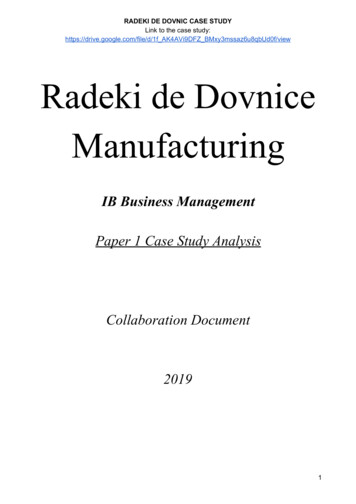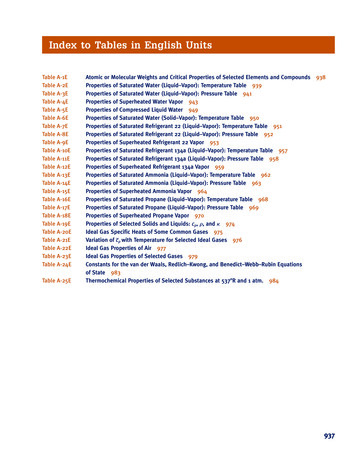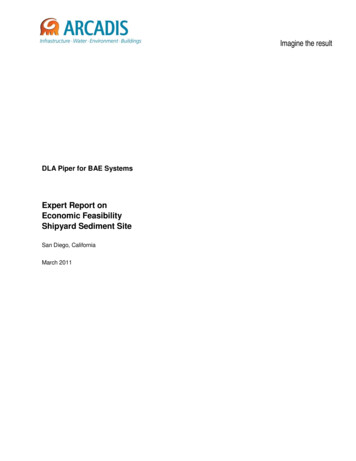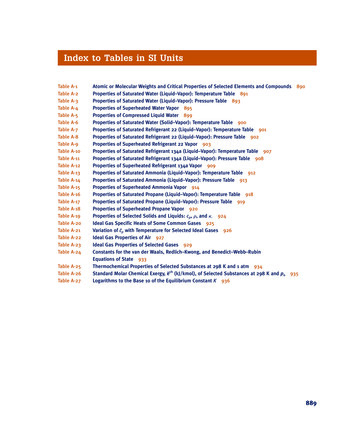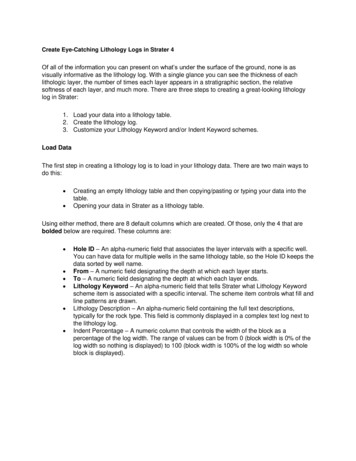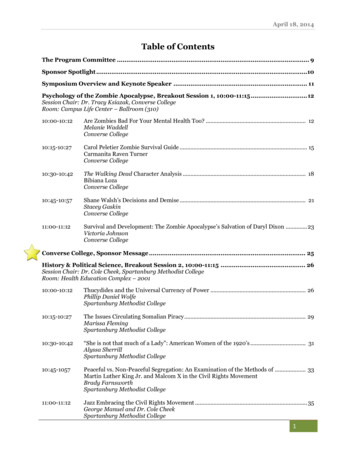
Transcription
April 18, 2014Table of ContentsThe Program Committee . 9Sponsor Spotlight .10Symposium Overview and Keynote Speaker . 11Psychology of the Zombie Apocalypse, Breakout Session 1, 10:00-11:15 . 12Session Chair: Dr. Tracy Ksiazak, Converse CollegeRoom: Campus Life Center – Ballroom (310)10:00-10:12Are Zombies Bad For Your Mental Health Too? . 12Melanie WaddellConverse College10:15-10:27Carol Peletier Zombie Survival Guide . 15Carmanita Raven TurnerConverse College10:30-10:42The Walking Dead Character Analysis . 18Bibiana LozaConverse College10:45-10:57Shane Walsh’s Decisions and Demise . 21Stacey GaskinConverse College11:00-11:12Survival and Development: The Zombie Apocalypse’s Salvation of Daryl Dixon . 23Victoria JohnsonConverse CollegeConverse College, Sponsor Message . 25History & Political Science, Breakout Session 2, 10:00-11:15 . 26Session Chair: Dr. Cole Cheek, Spartanburg Methodist CollegeRoom: Health Education Complex – 200110:00-10:12Thucydides and the Universal Currency of Power . 26Phillip Daniel WolfeSpartanburg Methodist College10:15-10:27The Issues Circulating Somalian Piracy . 29Marissa FlemingSpartanburg Methodist College10:30-10:42“She is not that much of a Lady”: American Women of the 1920’s . 31Alyssa SherrillSpartanburg Methodist College10:45-1057Peaceful vs. Non-Peaceful Segregation: An Examination of the Methods of . 33Martin Luther King Jr. and Malcom X in the Civil Rights MovementBrady FarnsworthSpartanburg Methodist College11:00-11:12Jazz Embracing the Civil Rights Movement . 35George Manuel and Dr. Cole CheekSpartanburg Methodist College1
Tenth Annual SC Upstate Research SymposiumChemistry & Physics, Breakout Session 3, 10:00-11:15 . 37Session Chair: Dr. Albert D. Dukes III, Lander UniversityRoom: Health Education Complex – 203910:00-10:12Temperature Effects on the Morphology of CdSe Nanocrystals . 37Albert D. Dukes III, Michael Tanner Cameron, Jordan C. Ashley, and Ralph C. LaylandLander University10:15-10:27Investigation of the Origin of the Diet Coke and Mentos Reaction . 40David E. Gardner, Albert D. Dukes III, and Bhargay R. PatelLander University10:30-10:42An Improved Synthesis of an Alkynyl-Bacteriochlorin . 43Ryan D. Dolewski, Steve Kerbs, and Dr. Joshua V. RuppelUSC Upstate10:45-10:57Using FTIR Spectroscopy to Measure Glucose Concentrations . 46M. Paige Ouzts and William M. BakerLander University11:00-11:12Study of Rockett Atomic Potential for CdTe Semiconductor Compound . 49Jung OhSpartanburg Community CollegeGreenville Tech, Sponsor Message . 52Business & Entrepreneurship, Breakout Session 4, 10:00-11:15 . 53Session Chair: Dr. Charles Harrington, USC UpstateRoom: Campus Life Center – 31710:00-10:12Culturally Relevant Strategies for Supporting American Indian Entrepreneurship . 54Dr. Charles HarringtonUSC Upstate10:15-10:27The Economic Impact of Hunting in South Carolina . 56Dr. Charles Harrington and Lanise M. DonaldUSC Upstate10:30-10:42The Development of a Performing Artist via the Art of Concert Production . 59Blake Lewis and Dr. Tricia OneyUSC Upstate10:45-10:57The Critical Impact of Revenue and Cash Flow on a Successful Medical Practice . 62Dr. Lydia A. Edmonds and Charlotte HoukeSouthern Wesleyan University11:00-11:12The IT Access Security Process: Speed of Execution and Customer Satisfaction . 65Kathryn L. Bongard and Charlotte HoukeSouthern Wesleyan UniversityLander University, Sponsor Message . 68Culture & Society, Breakout Session 5, 11:35-12:50 . 69Session Chair: Dr.Warren J. Bareiss , USC UpstateRoom: Campus Life Center – Ballroom (310)2
April 18, 201411:35-11:47Evil Mothers and Rebelliouss Daughters: Popular Self-Injury Films . 60Warren J. BareissUSC Upstate11:50-12:02Graffiti Culture as an Emerging Art Movement . 72Kyndell G. BevisSpartnaburg Methodist College12:05-12:17Effects of Competitive and Cooperative Violent Game Play on Aggressive Behavior . 74Gordon OverholtzerSouthern Wesleyan University12:20-12:32The Effects of Essentialist Labels on Beliefs About Moral Conversion . 77Brenna BylerConverse College12:35-12:47Jurors’ Judgements About Recanted Confessions . 80Dr. Dawn McQuiston, Tara Gough, Ross Hill, Meghan Holland, and Chuck LehmullerWofford CollegeLimestone College, Sponsor Message . 82Literature, Breakout Session 6, 11:35-12:50 . 83Session Chair: Dr. Colleen C. O’Brien, USC UpstateRoom: Health Education Complex – 200111:35-11:47A Return to the Living . 83Thomas McConnellUSC Upstate11:50-12:02Concepts of Agarian Freedom in the Americas . 87Colleen C. O’BrienUSC Upstate12:05-12:17La Transformation de la Femme Migrante; du corps enfermée à l’ esprit libre. . 89À partir d’Inch’allah Dimanche de Yamina Benguigui.Xinyi TanUSC Upstate12:20-12:32When Reality is Stranger than Fiction: To Kill a Mockingbird, Race, . 92and the Scottsboro BoysLeah Meahl, Dr. Cole Cheek, and Dr. Jonathan SedberrySpartanburg Methodist College12:35-12:47The Psychological Effects of Feminine Beauty in A Streetcar Named Desire . 95Paul AdamsUSC UpstateThe Metropolitan Studies Institute, Sponsor Message . 98Biology I, Breakout Session 7, 11:35-12:50 . 99Session Chair: Dr. John Hart, Sherman College of ChiropracticRoom: Health Education Complex – 20393
Tenth Annual SC Upstate Research Symposium11:35-11:47Estimating Species Richness and Relative Abundance of Ticks in the Upstate of . 99South Carolina for the Purpose of Assessing the Risk of Human Tick-borne DiseaseJonathan Williams and Dr. Rocky NationSouthern Wesleyan University11:50-12:02Small Mammal Community Structure within Urban Greenways . 102Samantha Poarch, Joseph M. Morrissey, Theodore Khleborodand Dr. Jonathan J. StormUSC Upstate12:05-12:17Determining the Cuticular Hydrocarbons Involved in Chemosensory Systems . 105of the Parasitoid Wasp, Dasymutilla occidentalisDeep B. Sangani, Bradley A. Vaughn, John F. Moeller, Caleb A. ArringtonWofford College12:20-12:32Petals Abscise Earlier Under Hot, Dry Conditions for Linum rigidum, . 107a Dry Prairie SpeciesMiranda N. Dey, Caleb W. Phillips, and Dr. Benjamin R. MontgomeryUSC Upstate12:35-12:47Comparison of Resting Pulse Rates in Chiropractic Students vs. . 110the General PopulationJohn HartSherman College of ChiropracticSherman College of Chiropractic, Sponsor Message . 112Linking Pedagogy with Student Outcomes, Breakout Session 8, 11:35-12:50 . 113Session Chair: Dr. Holly Pae, USC UpstateRoom: Campus Life Center – 31711:35-11:47A Comparison of Student Performance Between Lower-Division and Upper-Division . 113Business Courses in Online vs. Tradtitional Deliver MethodsT. Brian Smith and Dr. Rosalind C. PaigeUSC Upstate11:50-12:02Results from Mathematics Development Course Redesign . 116Stephen H. Fast and Christian D. MineoLimestone College12:05-12:17Multi-User-Virtual Environments Enhances Student Learning . 118Dr. Darlene Amendolair, Sharon Smith, Catherine B. TalleyUSC Upstate12:20-12:32Evaluating Teacher-Training Programs: Do Praxis II Scores and GPAs . 121Predict Teacher Effectiveness?Holly PaeUSC UpstateSpartanburg Community College, Sponsor Message . 124Poster Session, 2:00-3:00 . 125Room: Campus Life Center – Ballroom (310)Shoreline Change Analysis of Seabrook Island, SC . 125Briget C. Doyle and Madelyne R. AdamsUSC Upstate4
April 18, 2014Abundance of Carnivorous Mammals in Urban Greenways and Rural Forests . 128Joseph M. Morrissey, Samantha L. Poarch, and Jonathan J. StormUSC UpstateImpact of Nocturnal Temperature Variation on the Calling Activity of Anaxyrus fowleri, . 131Hyla chrysoscelis, and Hyla cinereaJarad P. Cochran, Adrian K.-O. Hayes, Elliott P. Gibbs, and Dr. Melissa PilgrimUSC UpstateImpact of Eastern Hemlock (Tsuga canadensis) Loss Caused by Hemlock Woolly Adelgid . 135(Adelges tsugae) Infestation on Soil, Stream and Freshwater Macroinvertebrate EcologyTatiana D. ManidisWofford CollegeIdentification and Characterization of Pythium Species Associated with Cotton Field Soil in . 138South CarolinaJasmine Bodison-Frasier and M. Valeria AvanzatoCoker CollegeFactors Influencing Seed Germination for Linum rigidum (Yellow Stiff Flax) . 141Brittany P. Twitty and Dr. Benjamin MontgomeryUSC UpstateDoes Loss of Sterol-Sensing Domain Transmembrane Segments Alter the Trc8 Protein’s Growth . 144Inhibitory Effects in HEK293 Cells?Morgan B. Buckner and Jason P. LeeLander UniversityComparative Study of the Effects of Sweeteners on the Blood Glucose Level and Weight of . 147Rattus norvegicusBrianna Miller, Anjali Amalean, and Edna SteeleDorman High School and Converse CollegeDiseases Affecting Synthesis and Ligand Binding to Hemoglobin . 150Megan WangWofford CollegeInfluence of pH on the Removal of Chromium Species Using Lysine Functionalized . 152Magnetic Iron NanoparticlesMichael Eaves and Anselm OmoikeUSC UpstateSynthesis of Two Dimensionally and One Dimensionally Confined Cadmium Selenide Nanocrystals . 155Michael T. Cameron, Albert D. Dukes III, Jordan C. Ashley, and Ralph C. LaylandLander UniversityStereotypes About Higher Level of Education . 158Megan Banks and Seunggeun HyunUSC UpstateThe Influence of Varying Surface Tension on Tissue Fusion . 161Elijiah Wright, Jaime Jahuey, and Xinli WangUSC UpstateTransport of Brownian Particles From a Solid Obstacle at Large Peclet Numbers . 164Jaime Jahuey and Xinli Wang5
Tenth Annual SC Upstate Research SymposiumUSC UpstateFactors Influencing a Woman’s Decision to Receive Medical Treatment for Infertility . 167Kelsey Ward and Calvin OdhiamboUSC UpstateEvaluating Sex Differences in Migraines . 172Katherine E. Kay and Calvin OdhiamboUSC UpstateWhy Black Women Have Higher Mortality Rates for Breast Cancer Compared to White Women . 175Karmen Gaffney and Calvin OdhiamboUSC UpstateThe Existence of Implicit Racial Bias in Nursing Faculty . 179Dr. Kathleen FitzsimmonsUSC UpstateDecreasing Hemolysis Rates in Emergency Department Patients . 184Sanquinette Brownlee and Dr. Lynette M. GibsonMary Black School of Nursing, Greenville CampusVariation in Implementation of Electronic Health Record (EHR) Functionalities . 185Across Hospital CharacteristicsAmanda Stevens and Dr. Deshia LeonhirthUSC UpstateCritiquing Fall Assessment Tools . 189GraceAnna Baker, LaTonya Simmons, and Dr. Lynetta M. GibsonMary Black School of Nursing, Greenville CampusImpact of Presentence Investigation Report Types and Gender on the Sentencing of Offenders . 192Brittany Kridle, CeLeasa Conner and Susan RuppelUSC UpstateThe Role of Intent in Deception . 195Chase Moery, Kimberly Preusse, and Dr. Scott MeekUSC Upstate, Georgia Institute of TechnologyBrony Fans vs. Non Fans: Comparing Individual Differences and Beliefs . 199Jessica Langley, Jan Griffin, Patrick Edwards, Daniel Chadborn, and Marsha ReddenUSC UpstateFinding Meaning Within a Fandom: Not all Fans are Alike . 202Talia Rojas, Patrick Edwards, Jan Griffin, Daniel Chadborn, and Marsha ReddenUSC UpstatePresence of Sustainability Indicators in Five South Carolina Cities. 205Natalia C. RosarioUSC UpstateSharing Mission Statements Through Story Telling. 209Julie Holt, Jessica Kendrick, Marlene Shields, Kate Sortet, Megan Trinkleback, Rebecca Williams,Sarah Williams, Rachael Wilson, and XinXin ZengUSC UpstateSpartanburg Methodist College, Sponsor Message. 2126
April 18, 2014Psychology & Sociology of Relationships, Breakout Session 9, 3:10-4:10 . 213Session Chair: Dr. Clifton P. Flynn, USC UpstateRoom: Campus Life Center – Ballroom (310)3:10-3:22Escalated Exposure: First Impressions of Personality and Trust Judgments . 213Stacey M. Olson, Dr. Andrew Beer, and Caitlin ChaneyUSC Upstate3:25-3:37A Home Away from Home: The Benefits of Assisted Living Facilities . 216Alyssa M. SherrillSpartanburg Methodist College3:40-3:52Divorce, Parental Conflict and Adult Children’s Relationship Attitudes: . 218Examining the ConnectionBrittany Eversole, Clifton P. Flynn, and Laura JenningsUSC UpstateLinguistics, Breakout Session 10, 3:10-4:10 . 222Session Chair: Dr. David Marlow, USC UpstateRoom: Health Education Complex – 20013:10-3:22Teachin’ Good: Dialects in Education and Life . n/aDr. David MarlowUSC Upstate3:25-3:37Language in the Classroom: An Observation . 222Jonathan Griffin and Dr. David MarlowUSC Upstate3:40-3:52Sorry, I Must Dash: On the Use of Punctuation in Harry Potter and . 225the Sorcerer’s StoneYvonne Kao and Dr. David MarlowUSC UpstateUSC Upstate, Sponsor Message . 229Biology II, Breakout Session 11, 3:10-4:10 . 230Session Chair: Dr. Ginny Webb, USC UpstateRoom: Health Education Complex – 20393:10-3:22Anticancer Effects of Blueberry and Pomegranate Extracts on the AGS Gastric . 230Adenocarcinoma Cell LineDaniel’le Devoss, Kianna Moss, and Dr. Kathy RomeroGreenville Technical College3:25-3:37The Effect of Antifungal Drugs on Antiphagocytic Protein 1, a Virulence Factor of . 232Cryptococcus neoformansCody Orr and Ginny WebbUSC Upstate3:40-3:52Identification of Local Plants Using DNA Barcodes . 235Deniz DoğanGreenville Technical CollegeWofford College, Sponsor Message . 2387
Tenth Annual SC Upstate Research SymposiumInformatics, Breakout Session 12, 3:10-4:10 . 239Session Chair: Dr. Deshia LeonhirthRoom: Campus Life Center – 3173:10-3:22Action Rules Discovery of Lowest Cost . 239Angelina A. TzachevaUSC Upstate3:25-3:37Modeling Innovation with BACUP . 242Ron FulbrightUSC Upstate3:40-3:52Incorporating Disruptive and Incremental I-TRIZ Innovation into Six Sigma. 245Ron Fulbright and Keith HansenUSC Upstate8
April 18, 2014The 2014 Program CommitteeDr. Melissa PilgrimSymposium ChairAssociate Professor of BiologyDirector of Research, USC UpstateDr. John HartAssociate Professor of Clinical SciencesAssistant Director of ResearchSherman College of ChiropracticDr. Caleb ArringtonAssociate Professor of ChemistryWofford CollegeDr. Crystal Hill-ChapmanAssistant Professor of PsychologyFrancis Marion UniversityDr. Kathleen BradyMetropolitan Studies InstituteUSC UpstateDr. Berta H. HopkinsChair, Science DepartmentSpartanburg Community CollegeDr. Royce CainesDean and ProfessorSchool of BusinessSouthern Wesleyan UniversityElaine MarshallSponsored AwardsUSC UpstateDr. Cole CheekProfessor of History and AnthropologySpartanburg Methodist CollegeDr. Tamara McGovernAssistant Professor of BiologyLimestone CollegeDr. Jeff CookProfessor of HistoryNorth Greenville UniversityDr. Lee EdwardsAcademic Program Director, BiologyGreenville Technical CollegeDr. Neval ErturkAssociate Professor of BiologyConverse CollegeDr. Latha GearhartAssociate Professor of ChemistryPresbyterian CollegeCherie PressleyHigh School Participation ChairUpstate Regional Education Center CoordinatorUSC UpstateDr. David SlimmerDean, College of Science and MathematicsProfessor of PhysicsLander UniversityDr. Bill WrightClinical Assistant ProfessorUSC Upstate Department of Biomedical SciencesUSC School of Medicine Greenville9
Tenth Annual SC Upstate Research SymposiumSINCERE THANKS TO OUR SPONSORS10
April 18, 2014PROGRAM -10:00Registration, Poster Set-up in the Campus Life CenterWelcome: Dr. Tom Moore, USC Upstate ChancellorOpening Remarks: Dr. Melissa PilgrimKeynote Address: Dr. Louis Guillette, Medical University of South Carolina10:00-11:15Breakout Sessions 1, 2, 3, 4BallroomCLC BallroomCLC BallroomCLC BallroomAttendees/Presenters Report to Breakout SessionsBreakout Session 1: Psychology of the Zombie ApocalypseBreakout Session 2: History & Political ScienceBreakout Session 3: Chemistry & PhysicsBreakout Session 4: Business & Entrepreneurship11:15-11:25Coffee Break11:25-11:35Attendees/Presenters Report to Breakout Sessions11:35-12:50Breakout Sessions 5, 6, 7, 8CLC BallroomHEC 2001HEC 2039CLC 317Breakout Session 5: Culture & SocietyBreakout Session 6: LiteratureBreakout Session 7: Biology IBreakout Session 8: Linking Pedagogy with Student OutcomesCLC BallroomHEC 2001HEC 2039CLC 317CLC Ballroom2:00-3:00LunchPoster Session3:00-3:10Attendees/Presenters Report to Breakout Sessions3:10-4:10Breakout Sessions 9, 10, 11, 1212:50-2:004:20-5:205:50-6:20pmCLC BallroomBreakout Session 9: Psychology & Sociology of RelationshipsBreakout Session 10: LinguisticsBreakout Session 11: Biology IIBreakout Session 12: InformaticsCLC BallroomHEC 2001HEC 2039CLC 317Fireside Social and Award CeremonyPoster Breakdown & Distribution of ReviewsRoel PavillionKeynote SpeakerDr. Louis J. Guillette, Jr., holds a professorship in obstetrics and gynecology at the Medical Universityof South Carolina and is the CoEE Endowed Chair in Marine Genomics at the Hollings MarineLaboratory. Professor Guillette received his doctorate in comparative reproductive biology from theUniversity of Colorado at Boulder in 1981. Professor Guillette was a distinguished professor of biology atthe University of Florida for 25 years, where he was an award-winning teacher of biology, embryology andreproductive biology. In 2010 he was awarded the Heinz Medal, consideredthe major international award for work in the area of environmentalhealth. He is internationally recognized for his research in the field ofreproductive and developmental biology, having published over 300papers and edited five books. His research examining the role ofenvironmental contaminants as inducers of birth defects in various wildlifespecies and children has drawn international attention. His current workexamines the molecular (genomic and epigenetic), cellular and endocrinemechanisms associated with genital and gonadal development andcontaminant-induced bnormalities.11
Tenth Annual SC Upstate Research SymposiumAre Zombies Bad for Your Mental Health Too?Melanie WaddellPsychologyConverse College580 E. Main St. Spartanburg, SC 29304Melanie.waddell@converse.eduAbstract – The Walking Dead (Darabont & Hurd,2010) affords us the opportunity to study the effects ofdisaster and aftermath on vulnerable populations. Thisfictional representation of people in crisis can serve as adiagnostic tool to help train or increase skills in disasterresponse. Using Carl as a model, we can identifywhether his mental health is affected; and using hisinteraction with the group, we can determine variousprojections about the future of the character. ThoughCarl does not exhibit any signs of disaster relateddisorders, or decreased mental health, he is at extremerisk for developing adverse mental health in the future.Keywords — Walking Dead, Disasters, Psychosocial,PTSDIntroductionDisasters can affect people in many differentways; not only because of the traumatic eventsthemselves, but also because of the succeedingevents, or the aftermath. There are specificingrained responses to disaster, or what weperceive as threats: fight, flight, or freeze (Ksiazak,2014 January 10). In the event of a disaster, ourbrains are acting from a more primal state,responding on a more primitive level using thehippocampus (Ripley, 2008). Common reactions todisaster include loss of senses, memory, andrational thinking. What this means for those whosuffer from a disaster is that they can often incurequal, if not increased damage from the aftermathof the disaster as well as the event itself. Toillustrate this, we have used the popular televisionseries The Walking Dead (Darabont & Hurd, 2010)in an attempt to analyze the effects of disasters andtheir aftermath.Disaster ResearchDisaster related research is confined bynature. As researchers, we are limited in our abilityto analyze the effects of disaster to responding tonaturally occurring disasters. In those situations,research into psychological responses to disaster isnot a high priority. Thus, a researcher is only ableto survey the affected population or create anexperiment to analyze disaster and aftermatheffects. Except, we cannot always survey affectedpopulations due to relocation, death, injury, and12any number of post-disaster conditions. If we areable to survey an affected population, we cannot doso during a disaster or in the immediate aftermath,thereby affording us the chance to collect data fromsurvivors only after a prolonged time period. Thispost hoc data would be weakened by survivor’srecollections due to the time lapse between thedisaster and research, and could be vulnerable to anumber of additional concerns, as we’ve seen fromstudies conducted in the past (Roberts, Mitchell,Witman, & Taffaro, 2010). We also cannot inducedisaster conditions in an experiment. Theramifications of conducting an experimentinducing real disaster conditions would be horriblydamaging and highly unethical. While there arecertain constraints we face when using the show foranalysis, The Walking Dead is almost certainly oneof the most realistic disaster affected populationswe can expect to observe in the moment, given theaforementioned concerns. Though the show isfictional in its content, the reactions of thecharacters’ are meant to portray an accurate or atleast quasi-accurate representation of humanresponse to disaster, trauma, death, tragedy, etc.Therefore, analysis of The Walking Dead canactually provide useful diagnostic material relevantto post-disaster issues. In an area where field studyis usually subjected to flaws and expense, utilizingpopular media such as The Walking Dead canprove a useful training tool.SCENARIOThe Walking Dead chronicles the story of agroup of survivors squaring off against zombies.The characters in season one of the series haveescaped death and un-death, but their lives arethreatened almost daily. Carl Grimes is thecharacter we will be analyzing for signs of mentalhealth issues post-disaster, but there are a numberof other characters who play a large part in hisreaction to the Zombie Apocalypse. Prior to the riseof zombies, Rick Grimes was a Sheriff’s Deputy. Heis married to Lori, and they have a son: Carl, age 12.Shane Walsh, another member of the group, wasRick’s partner and his best friend. These charactersall comprise Carl’s family unit at one point.Another important figure in Carl’s life is Sophia, ayoung girl his age. These characters are the most
April 18, 2014influential in Carl’s life during the ZombieApocalypse.It is revealed in “Wildfire” that the zombievirus went global 63 days ago. We know that Rickrecently awoke in the hospital from a coma beforebecoming part of the group, and Dr. Edwin Jennerof the CDC said the virus spreads like wildfire;therefore, we can assume that it has beenapproximately two months since the virus became adisaster. Though the timeframe may seem like anonissue, it can actually help us pinpoint differentindividual responses to the disaster, as well asgroup response. Since the disaster is ongoing, theactual response from survivors is different than wecould expect to see in the survivors of otherdisasters which are not as extensive in duration. Ifwe try to compare the group to where a normalsurvivor population would be in terms of recovery,we can see that the phases of disaster will be muchlonger for the group because of the ongoingtrauma. However, using the disaster model(Ksiazak, 2014 January 23) we can see that thegroup is progressing through the stages of responseat a somewhat normal pace, given small variance toaccount for the ongoing nature of ‘Impact’. One ofthe ways we see the group trying to adapt is in theircreation of a new normal. Though life is not thesame, it does gain a semblance of normality,especially for the children. Instead of attendingschool, they routinely learn from textbooks andparents. They continue to be able to play andengage in childlike pastimes. When the grouptravels to the CDC in Atlanta, they experiencestandards of living which they had not possessed inthe camp. For children, the success of adapting todisaster situations and maintaining mental healthis a return to routine and normalcy (Rao, 2006).The “maintenance of the status quo” (Cox & Perry,2011, p. 408) is important in recovering from adisaster.The most common disorders arising fromdisasters are post traumatic stress disorder,depression, and substance abuse (Ksiazak, 2014January 16). Carl does not exhibit overt symptomsof any of these. Though we do not see Carldocumented in every moment, when we see him,we never see signs of these disorders, indicatingCarl has good mental health. Perhaps this isbecause of his resilience or his moral development,which will be discussed further in the analysis.Ripley (2008) bases her theory of disasterresponse on three stages: denial, deliberation, anddecision. Through extensive research into a varietyof recent traumas, Ripley crafted her three stageresponse, which values the importance ofresilience. Resilience is the main factor indetermining how people will respond to a disaster:“They believe they can influence what happens tothem. They find meaningful purpose in life’sturmoil. They are convinced that they can learnfrom both good and bad experiences,” (Ripley,2008, p. 230). In Carl’s case, it is difficult todetermine his resilience; however, we can see thathe has not given up hope, and he learns from bothgood and bad experiences. Also, the l
Session Chair: Dr. Albert D. Dukes III, Lander University Room: Health Education Complex - 2039 10:00-10:12 Temperature Effects on the Morphology of CdSe Nanocrystals. 37 Albert D. Dukes III, Michael Tanner Cameron, Jordan C. Ashley, and Ralph C. Layland Lander University

